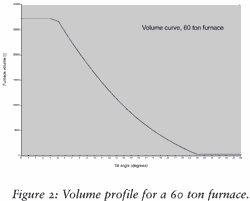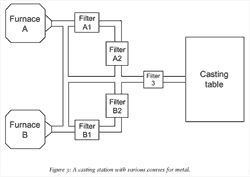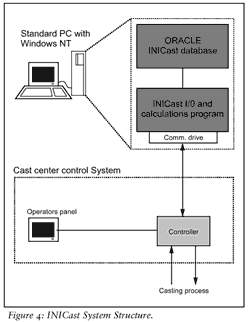
Function description
The patented method is based on the fact that there is a relation between furnace volume, tilt angle and the metal level in the furnace tap-out. This relation is called the Furnace Volume Profile (FVP). When the FVP is known (calculated by the system) the actual molten metal volume in the furnace is calculated using the tilt angle and the metal level in the furnace tap-out. The volume profile for a furnace will change over time due to phenomena like fouling, wear and tear etc. The system will automatically generate and store a new furnace curve for each cast. These stored curves will be the input for a generation of a new volume profile. The most important reason why the method works in practice, is the fact that there are separate functions in the system for generation and maintenance of the volume profile. Figure 2 shows an example of a volume profile for a 60 ton casting furnace at Elkem Aluminium Mosjøen, Norway which is generated by the system in daily opera-tion.
 In determining the metal volume available before casting,
the metal volume in troughs, filters and casting table has
to be taken into account. A casting station often has
various courses for the metal from the furnace to the
casting table, depending on metal treatment to be given.
This means that the metal volume on its way between
furnace and casting table can vary quite a lot from casting
to casting. See figure 3. The system takes into account the
metal´s course in the station in question to be able to
correct these deviations. The system automatically
calculates the different volumes at different courses.
In determining the metal volume available before casting,
the metal volume in troughs, filters and casting table has
to be taken into account. A casting station often has
various courses for the metal from the furnace to the
casting table, depending on metal treatment to be given.
This means that the metal volume on its way between
furnace and casting table can vary quite a lot from casting
to casting. See figure 3. The system takes into account the
metal´s course in the station in question to be able to
correct these deviations. The system automatically
calculates the different volumes at different courses.
Since the system continuously estimates the available metal volume for the cast, the operator can be warned during casting if there is too little metal in the system to achieve the desired casting length. The early warning enables the operator to shut off a few molds early in the casting instead of all the billets becoming too short. At the end of the process, the remains of metal in the furnace is determined. This is the start of the next charge. The remains of metal is an important parameter to achieve the correct metal volume and metal analysis when the next charge is to be alloyed.


